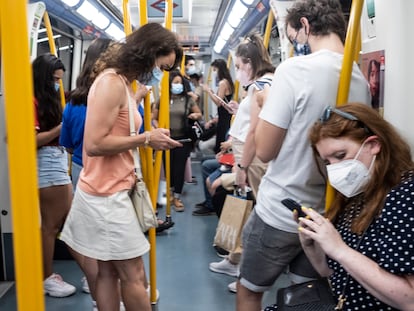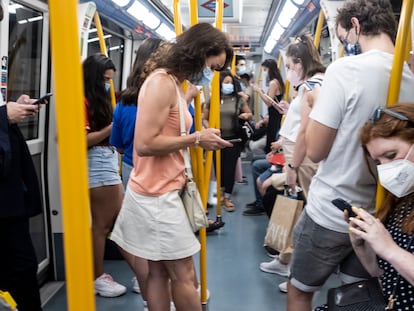A week without a smartphone: ‘I read a book for the first time in six years’
A study by several public universities reports that young people spend an average of five hours a day on their phones, and say they don’t feel well informed by traditional media


Go a week without your smartphone. That was the challenge accepted last May by 92 young Spaniards (ages 15 to 24) who participated in a research study led by several Spanish and European universities to analyze their information sources. According to the Reuters Institute, 39% of people between the ages of 18 and 24 use social networks as their main source of news. After seven days disconnected from their smartphones, most of the study group said they felt poorly informed. For news, they mostly turned to TV and radio, and a few looked at print newspaper. “As soon as I open my eyes in the morning, I look at Instagram to get the daily news. I felt a little lost without my phone,” said Lorena Vegas, a 21-year-old study participant. Like many others in the group, she read her first book in years – Megan Maxwell’s bestseller, ¿Un último baile, milady? (One Last Dance, Milady?)
“We decided to conduct this study out of concern for indications that young people are turning to dubious sources of information, to actors outside the journalistic profession. The future of our society seems to be content with this dumbed-down content,” said lead researcher Pedro Farias, a professor of journalism at Spain’s University of Málaga. One of the objectives of the study that will conclude in 2023 is to analyze the elements that influence almost 9,000 young Europeans to trust certain content, and what motivates them to share or not share that content on social media.
The study financed by Spain’s Ministry of Science and Innovation monitored the participants’ use of smartphones for three weeks (May-July 2022). During the first week, study participants were observed using their devices as normal. The devices were taken away for the second week of observation and returned for the third week. Participants were asked to record their thoughts in a daily diary and answer weekly surveys. During the first week, study participants recorded an average of five hours a day of smartphone use, four of which were on social media. WhatsApp was the most-used app, followed by Instagram and TikTok, which is quickly becoming the sole information channel for the youngest users.
When deprived of their smartphones, the study participants reported feeling uneasiness, anxiety, insecurity and dependence, although it felt liberating for a few. Many of those surveyed said things like, “I felt calmer just by having it close by”; “I had more anxiety than when I tried to quit smoking”; and “Seeing everyone on public transportation with their phones made me want to use mine.” Most participants reported feeling closer to their families during the week of deprivation, with comments like, “When I’m home, I usually go to my room after dinner to watch TikTok. I had more family life without my phone”; “I watched a TV series with my parents without any distractions – I enjoyed it”; and “This week we didn’t argue about my phone use, which was a relief.”
Another advantage reported by the study participants was a greater focus on academics – “It helped me a lot to be without a phone; I did all my schoolwork faster.” Some talked about reading physical books – “I read a whole book. It’s been six years since I read one just for enjoyment.”
The researchers that conducted the study believe that this type of experiment makes young people think about their digital excesses. Lorena Vargas told us in a phone interview that her nights are all about TikTok. Before going to bed, she lets the app’s algorithm randomly present comedy and dance videos that she watches for about four hours. “I live with three roommates. We chat a bit after dinner and then we all go to our own rooms. I haven’t watched TV in years.” She started reading novels and essays again during her week without a phone, and now only spends two hours a night on social media. We ask – do you think it will last? “Well, I really don’t know,” she says.
During her week without a phone, Vargas was oblivious to current events. “The news comes to you on your phone, so you don’t have to go looking for it,” she said. Most of the participants said that buying a newspaper “is a waste,” because it’s spending money on something that happened in the past when the most up-to-date news is available for free on the internet.
The joint Reuters Institute-Oxford University Digital News Report 2022 was based on more than 93,000 interviews with consumers in 46 countries. It warns traditional news outlets about the challenges they will continue to face in attracting new generations to their content, and getting them to pay for it. Currently, the average subscriber is 47 years old, and new subscribers under 30 represent a small part of the market in countries like the United Kingdom (8%) and the United States (17%). The report notes that young people find it difficult to understand the language used by traditional media and their story-telling methods. The use of TikTok as an information source has risen from 3% in 2020 to 15% in 2022. TikTok viewers are hooked by content that’s more informal, personalized and diverse, in addition to the live video.
The inter-governmental Organization for Economic Cooperation and Development (OECD) issued a report in 2021 titled, “21st-Century Readers: Developing Literacy Skills in a Digital World.” When 15-year-old students were asked whether they had difficulty identifying biased information, 46% of Spanish students reported having received school training on how to determine whether information is reliable or not. This was below the 54% average for the OECD countries surveyed. In Australia, Canada, Denmark and the United States, more than 70% of adolescents said they had received such training in school. When asked whether students were able to distinguish between facts and opinions, 41% of Spaniards said yes, compared to the 47% average for OECD countries.
But for some young people, giving up their smartphones for a week was not such a big deal. Amparo García said what she missed most was not having a GPS available. “It was a big drama … I had to print out a map!” She says she slept wonderfully without the pressure of having to answer messages from Whatsapp groups. This app and voice calls are what consume most of the four hours a day she spends on her phone. “When I turned it on again, I had 700 unread messages from 140 chats. That’s what takes most of my time – not all of us are glued to social media.”
Tu suscripción se está usando en otro dispositivo
¿Quieres añadir otro usuario a tu suscripción?
Si continúas leyendo en este dispositivo, no se podrá leer en el otro.
FlechaTu suscripción se está usando en otro dispositivo y solo puedes acceder a EL PAÍS desde un dispositivo a la vez.
Si quieres compartir tu cuenta, cambia tu suscripción a la modalidad Premium, así podrás añadir otro usuario. Cada uno accederá con su propia cuenta de email, lo que os permitirá personalizar vuestra experiencia en EL PAÍS.
¿Tienes una suscripción de empresa? Accede aquí para contratar más cuentas.
En el caso de no saber quién está usando tu cuenta, te recomendamos cambiar tu contraseña aquí.
Si decides continuar compartiendo tu cuenta, este mensaje se mostrará en tu dispositivo y en el de la otra persona que está usando tu cuenta de forma indefinida, afectando a tu experiencia de lectura. Puedes consultar aquí los términos y condiciones de la suscripción digital.
More information
Últimas noticias
The murder of Michele and Rob Reiner: A tale of horrific days in Hollywood
Trump orders a ‘complete blockade of sanctioned oil tankers’ going to and from Venezuela
Not all insomnia is the same: Study identifies five subtypes and paves the way for personalized treatment
The United States designates Clan del Golfo as a foreign terrorist group
Most viewed
- ‘El Limones’ and the growing union disguise of Mexican organized crime
- Christian Louboutin: ‘Young people don’t want to be like their parents. And if their parents wear sneakers, they’re going to look for something else’
- ‘We are dying’: Cuba sinks into a health crisis amid medicine shortages and misdiagnosis
- A mountaineer, accused of manslaughter for the death of his partner during a climb: He silenced his phone and refused a helicopter rescue
- The low-cost creative revolution: How technology is making art accessible to everyone










































